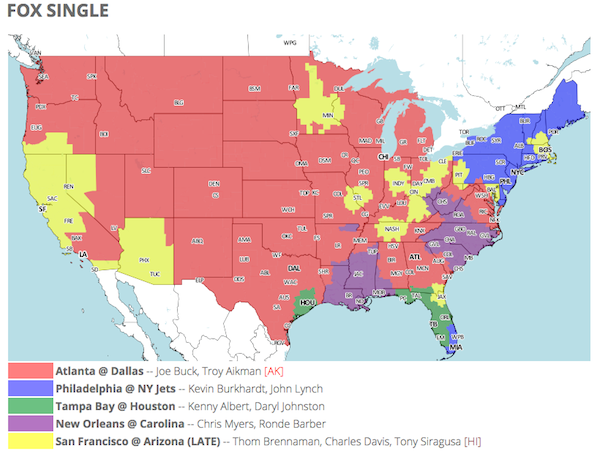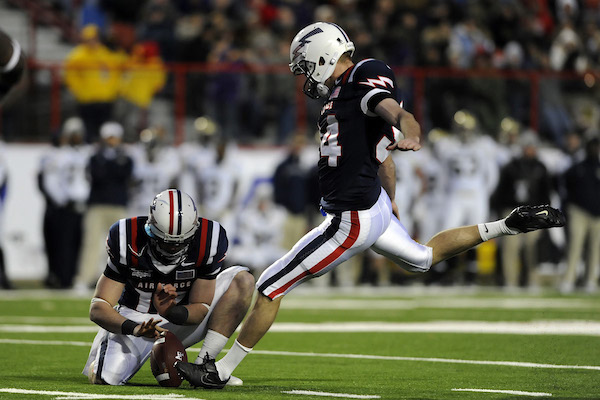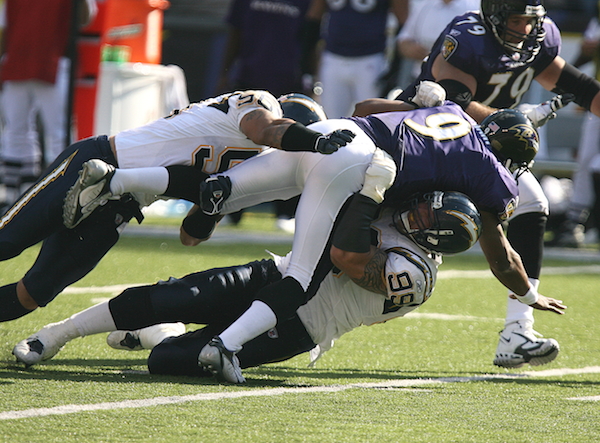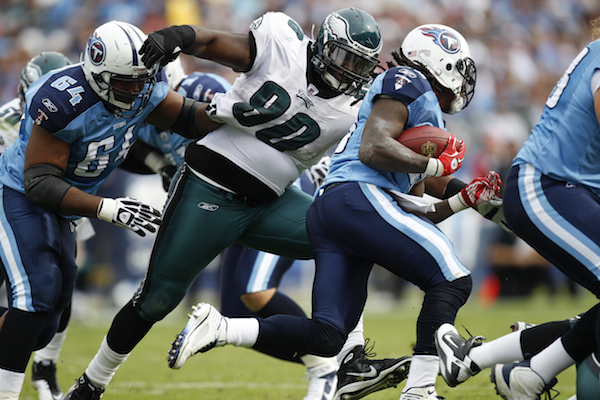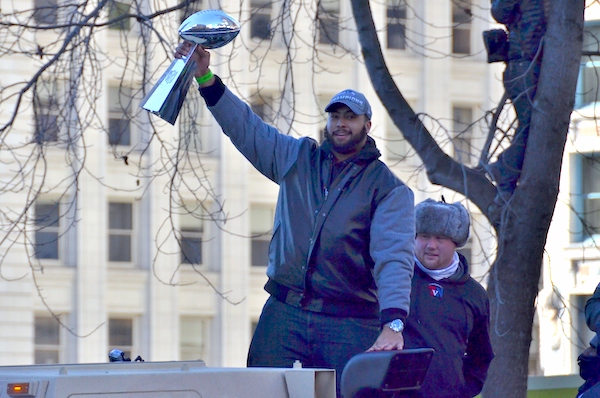Hello everyone and welcome to America’s favorite game show that… has never actually happened before and no one has heard of it… it’s Pitch That Game!
Here’s how it works. As your host, I have one minute to pitch a sporting event to someone who is not a sports fan. If, after my pitch, they’re interested in watching, I get a point! That’s it! Why would we play such a game? Well, it’s a good way to quickly learn about a set of games to see if you’re interested in following any of them. It’s also a great way for me to learn from you about what may or may not make a sport interesting to a layperson.
Our guest for this episode is Corinne Boet-Whitaker, a farmer and instrument and furniture maker. I pitched the five NFL football games available to people in the Boston area during the second weekend of the NFL season on Sunday September 20 and Monday September 21. For my thoughts on the other games, read on below the audio player.
Enjoy the show!
Sunday, September 27, 2015 1 p.m. ET
San Diego Chargers at Minnesota Vikings
Even though the two quarterbacks in this game, Phillip Rivers for the Chargers and Teddy Bridgewater for the Vikings, are on opposite sides of their careers, they’ve played quite similarly so far this year. Each has thrown the majority of their passes quite close to the line of scrimmage. Shorter passes are safer passes. The interpretation for Bridgewater, who is near the start of his career, has been that his coaches are sheltering him from the risks that he’ll learn to take as he grows into the job. Rivers, on the other hand, has spent most of his career slinging the ball all over the place, so this newfound conservatism is puzzling. It doesn’t seem like he’s lost any arm-strength, so maybe it’s simply a tactic that he or the coaches decided would work. I’ll be watching to see which quarterback, if any, gets more aggressive in this game.
Oakland Raiders at Cleveland Browns
Fans of the Raiders and the Browns have been watching their team’s anxiously for the past decade, looking for any signs that they might soon climb out of the NFL’s cellar, where they’ve been stuck for so long. The Raiders are coming off a big win last week over the Baltimore Ravens. The Browns are coming off an equally convincing victory over the Tennessee Titans. One of these teams will take a second step up the basement stairs this weekend. The other will hit their head on the ceiling and fall back down.
Cincinnati Bengals at Baltimore Ravens
The Ravens are one of several playoff teams from last year that have started this season with two losses. Of those teams, the Ravens are the one that have engendered the least worry among fans and prognosticators. This is because they started with two road games and they have such a stable recent history of winning that it seems inevitable for them to turn things around. All that may be true, but a loss in this game to Cincinnati would really get those alarm bells ringing in Baltimore. A Bengals win is not so far-fetched. The Bengals have played like an elite team so far this year. They have a solid defense, two excellent running backs, and a couple of great pass-catchers in wide receiver A. J. Green and tight end Tyler Eifert. Even their long-mocked quarterback, Andy Dalton, has played like an all-star this season. The Ravens will have to play their best to beat the Bengals.
New Orleans Saints at Carolina Panthers
A loss to the Panthers this weekend could signal the end of an era for the New Orleans Saints. The long-time partnership between coach Sean Payton and quarterback Drew Brees seems like it’s on its last legs. Brees has been battered and ineffective so far this season. He’s suffering from a seriously bruised rotator cuff and is questionable to even play in this game. Payton just doesn’t seem like the same kind of innovative coach that he did five years ago. A Saints loss would drop the team to 0-3 and severely damage their chances of salvaging this season. Carolina is always a tough place for the Saints to play — it’s outside and the Panthers have a brutally efficient defense — but it will be even tougher this weekend because Panthers fans and players would like nothing more than to be the camel that broke the football team’s back.
Atlanta Falcons at Dallas Cowboys
The Cowboys and Falcons are both 2-0 heading into this game, but the Cowboys seem to have made some kind of deal with the devil for their victories. Each win has come with a long-term injury to one of their best offensive players. Wide receiver Dez Bryant broke his foot in the team’s first victory and quarterback Tony Romo broke his collarbone in the second. If I were a superstitious Cowboys player, I might think twice about trying to win this game. I mean, really, at what cost? All jokes aside, it will be very difficult for the Cowboys to keep winning without their two best offensive players. If any offense could do it, it might be Dallas’ though, since it’s built around one of the strongest offensive lines in football. Even a relatively bad backup quarterback like Brandon Weeden should be able to complete throws if his line can keep all the defenders away from him.
Tampa Bay Buccaneers at Houston Texans
Tampa Bay Buccaneers rookie quarterback and probable rapist Jameis Winston said this week that he was looking forward to playing against Houston Texans fearsome defensive force of nature J. J. Watt. I am looking forward to watching Watt destroy Winston and make him look foolish.
Indianapolis Colts at Tennessee Titans
The Indianapolis Colts are another 0-2 team that was in the playoffs last year. They’ve been physically dominated in their first two games by the Buffalo Bills and New York Jets. It’s unclear whether Tennessee has the oomph and the athletes to do the same to them, but if they do, they have a clear blue print to follow. My guess is that the Colts win big in this game but there’s just enough suspense and certainly enough interest for me to want to watch and see how it turns out.
Pittsburgh Steelers at St. Louis Rams
This might be my favorite game this weekend. The Pittsburgh Steelers have looked like one of the best teams in the league this year, thanks to their balanced and dynamic offense. They’ve scored 71 points so far this season!! They’re one of the best teams in the league so far at running the ball and they might be even better passing. The only thing that can slow down their type of offense is exactly where the St. Louis Rams are best — an overwhelming defensive line. The Rams have a trio of defensive linemen, Robert Quinn, Chris Long, and Aaron Donald that basically all need to be double-teamed in order to keep them from tackling the opponent’s quarterback or running back. I am truly looking forward to seeing if the chaos caused by the Rams defense is enough to throw the Steelers off their game.
Philadelphia Eagles at New York Jets
If you judged teams by the number of words written about them during the offseason, the Eagles would be on their way to the Super Bowl and the Jets would be winless. In fact, it looks a little bit like the opposite is true. The Jets have surprised everyone and won their first two games in solid fashion. The Eagles have barely been able to get anything started on defense and have been profoundly vulnerable on offense. The vultures have already started circling around Philidelphia coach, Chip Kelly, and a loss this weekend could conceivably cost him his job.
Sunday, September 20, 2015 4:30 p.m. ET
Chicago Bears at Seattle Seahawks
Yikes. The winless, desperate, and generally pissed off Seattle Seahawks get to host the dysfunctional Chicago Bears. To make things worse for the Bears, their starting quarterback is out with an injured hamstring, so backup Jimmy Clausen will start the game against the Seahawks stellar defense. I guess the benefit of watching this game is that it will probably be decided conclusively in the first five minutes and then you can switch to another game? I will say, if the Bears can keep the game close, each minute that goes by will increase the pressure on the Seahawks tenfold.


